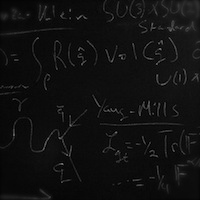Patterns are inexplicably tucked under the fabric of natural existence. Sometimes, with keen intuition and a strong analytical skill set, mathematical and theoretical physicists peel away the layers of entrancement exposing an ornate and cohesive structure underlying reality. Whether it is a newly predicted particle or describing the role of entropy in black holes, these masters of universal logic trudge through the vast corridors of imagination to uncover the character of physical law. With each new step, discoveries leap from the pages of theoretical manuscripts into a medley of experimental procedures.
In 1916, Albert Einstein’s General Theory of Relativity (generalizing his celebrated 1905 Special Theory of Relativity) revived the true essence of scientific discovery by explaining the nature of Newtonian universal gravitation. The basic tenant of the theory, captured in Einstein’s field equations, casts the force of gravity as a geometric entity of space and time. Although the theory is elegant in explaining gravity, it lacks the same luster in describing the dynamics of the other three fundamental forces: electromagnetism, the weak nuclear force, and the strong nuclear force. It is the framework of Quantum Mechanics that paints the intrinsic landscape of the remaining forces.
To a theoretician and experimentalist working in the area of unification, four fundamental forces are three too many. A plethora of theories (as documented by a mass of literature on the subject) have been put forth over decades to reconcile gravity with Quantum theory in a major attempt to build a complete picture of Quantum Gravity. In 1921, the mathematician Theordor Kaluza proposed a geometric theory by extending the Theory of General Relativity to a fifth dimension in hopes of unifying electromagnetism with gravity. Later in 1926, the theoretical physicist Oskar Klein proposed another theory in a similar geometric vein as Kaluza’s by postulating a certain circular shape of the fourth dimension, which combined with Kaluza’s attempt, became known as the Kaluza-Klein theory. Other theories, like the more modern Yang-Mills theories, utilize the concepts of algebraic groups, geometry, and gauge theory in hopes of eventually exposing a unifying thread weaving through the fabric of the fundamental forces.
This is a call to the mathematically minded everywhere to uncover new generalizations governing these forces. What tools should be used? Topology, Algebraic Geometry, Combinatorics, etc.? Providing new insights from the perspective of abstraction is the point where curiosity and imagination is met with discovery and the patterns tucked under the fabric of natural existence are exposed.

